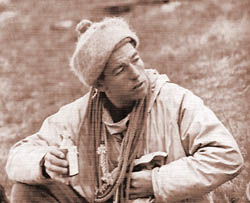Bouldering in England
in the 1940s A Conversation with Joe Brown . . . 2003 |
Page 5
 For
a glimpse of
bouldering in the United Kingdom during the 1940s, there's no better
person to consult than the great Joe Brown. I recently had a long chat
with Joe, in which we talked of a number of
things, particularly bouldering. For those of you too young to have
heard
of Brown, let me simply say that during the late 1940s and 1950s he was
one of the most skillful rock climbers in the world, and the first rock
climber to be well–known to the general public in
Great Britain. He
went on to become an outstanding expedition mountaineer with many
ascents
in the Alps, Himalayas, and elsewhere. For
a glimpse of
bouldering in the United Kingdom during the 1940s, there's no better
person to consult than the great Joe Brown. I recently had a long chat
with Joe, in which we talked of a number of
things, particularly bouldering. For those of you too young to have
heard
of Brown, let me simply say that during the late 1940s and 1950s he was
one of the most skillful rock climbers in the world, and the first rock
climber to be well–known to the general public in
Great Britain. He
went on to become an outstanding expedition mountaineer with many
ascents
in the Alps, Himalayas, and elsewhere.Joe started climbing in 1947, at the age of 16. Within two weeks after his first climbing experience, he and his companions began bouldering – primarily at Kinder Scout in the Peak District. Joe said that he climbed for several years in old-fashioned nailed boots, and found them to be very effective, even on boulders. He was able to edge on microscopic footholds with a nail or two – many boulder problems at the time required this - and climb in confidence. He talked of jumping from boulder to boulder and feeling very secure. When he first tried rubber-soled boots, he found the transition quite challenging, and felt insecure when boulder hopping. He and his companions could tell if anyone had worked on a particular problem by searching for nail-scratchings, the way modern boulderers look for chalk marks. Joe and his fellow climbers considered bouldering to be the obvious venue for competition in rock climbing. Although, he said, personally, he doesn't have a strongly competitive nature – in fact he seems very modest for all he has achieved. As we talked of the history of bouldering, Joe said that he believes virtually all climbers have engaged in the activity from time to time, and that he considers it to be a natural aspect of the rock climbing experience, remarking, for example, that climbers staying at a campground will usually find some sort of bouldering in the vicinity. The natural character of bouldering is even more pronounced in the British Isles, where large, glaciated mountains like the Alps are not to be found, and often climbers were unable to travel even to the larger cliffs at a distance from their homes, and were restricted to a few isolated boulders or outcrops - in much the same way Parisian climbers with limited time or funds were restricted to Fontainebleau. When we talked about Oscar Eckenstein, Joe said he thought that Eckenstein had possibly obtained some notoriety by doing a few problems other climbers found formidable – much the same situation we see today. He thinks that Eckenstein, although sometimes described in print as the first true boulderer, was possibly following a practice existing before him. That may well be. Unfortunately, before Eckenstein, documentation is virtually non-existent. And even Eckenstein's bouldering feats were inadequately described by his peers. First-hand accounts of his efforts on boulders are rare and lack any sort of detail, other than telling of him practicing balance climbing, lightly touching the rock, or climbing a problem others couldn't. Even the famous Eckenstein Boulder near Llanberis has slipped into obscurity, with few knowing which one it is. Joe was unable to find any photos of bouldering in his collection – and that's understandable to me, for when I was active and enthusiastically experimenting with my craft in the 1950s, I didn't bother with pictures either. The climbing environment was such that photographic records were almost exclusively restricted to 'important' ascents, long and exposed climbs. Joe and I both started climbing at the age of 16 – he in 1947 and me in 1953 - and we both began with manilla rope and remember suffering through its splinters as we rappelled the old-fashioned way, with the rope wound around our bodies. I bet we both have tiny scars on our backs from that experience! Joe
went on to make spectacular ascents in many of
the great mountain ranges of the world, and developed into one of the
finest all-round climbers the world has ever seen. What a pleasure it
was to talk with a true legend of climbing. And he still loves to climb
- go to his website and see Joe in action!
[Read his book: The Hard Years ] |